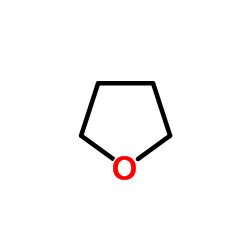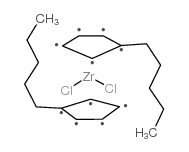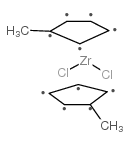Tetrachlorobis(tetrahydrofuran)zirconium

Tetrachlorobis(tetrahydrofuran)zirconium structure
|
Common Name | Tetrachlorobis(tetrahydrofuran)zirconium | ||
|---|---|---|---|---|
| CAS Number | 21959-01-3 | Molecular Weight | 377.24700 | |
| Density | N/A | Boiling Point | N/A | |
| Molecular Formula | C8H16Cl4O2Zr | Melting Point | 175-177 °C(lit.) | |
| MSDS | Chinese USA | Flash Point | N/A | |
| Symbol |



GHS02, GHS05, GHS07 |
Signal Word | Danger | |
| Name | oxolane,tetrachlorozirconium |
|---|---|
| Synonym | More Synonyms |
| Melting Point | 175-177 °C(lit.) |
|---|---|
| Molecular Formula | C8H16Cl4O2Zr |
| Molecular Weight | 377.24700 |
| Exact Mass | 373.89500 |
| PSA | 18.46000 |
| LogP | 4.35160 |
| Appearance of Characters | crystal,white |
| Vapour Pressure | 152mmHg at 25°C |
| Storage condition | 0-6°C |
Synonym:Zirconium(IV) chloride tetrahydrofura Section 2 - COMPOSITION, INFORMATION ON INGREDIENTS
Risk Phrases: 20/21/22 34 Section 3 - HAZARDS IDENTIFICATION EMERGENCY OVERVIEW
Harmful by inhalation, in contact with skin and if swallowed. Causes burns.Air sensitive.Moisture sensitive. Potential Health Effects Eye: Causes eye burns. Skin: Harmful if absorbed through the skin. Causes skin burns. Ingestion: Harmful if swallowed. Causes gastrointestinal tract burns. Inhalation: Harmful if inhaled. Causes chemical burns to the respiratory tract. Chronic: Not available. Section 4 - FIRST AID MEASURES Eyes: Immediately flush eyes with plenty of water for at least 15 minutes, occasionally lifting the upper and lower eyelids. Get medical aid immediately. Skin: Get medical aid immediately. Immediately flush skin with plenty of water for at least 15 minutes while removing contaminated clothing and shoes. Ingestion: Get medical aid immediately. Wash mouth out with water. Inhalation: Get medical aid immediately. Remove from exposure and move to fresh air immediately. If not breathing, give artificial respiration. If breathing is difficult, give oxygen. Get medical aid. Notes to Physician: Treat symptomatically and supportively. Section 5 - FIRE FIGHTING MEASURES General Information: As in any fire, wear a self-contained breathing apparatus in pressure-demand, MSHA/NIOSH (approved or equivalent), and full protective gear. Extinguishing Media: Use water spray, dry chemical, carbon dioxide, or chemical foam. Section 6 - ACCIDENTAL RELEASE MEASURES General Information: Use proper personal protective equipment as indicated in Section 8. Spills/Leaks: Vacuum or sweep up material and place into a suitable disposal container. Section 7 - HANDLING and STORAGE Handling: Do not breathe dust, vapor, mist, or gas. Do not get in eyes, on skin, or on clothing. Use only in a chemical fume hood. Storage: Store in a cool, dry place. Store in a tightly closed container. Corrosives area. Store under nitrogen. Section 8 - EXPOSURE CONTROLS, PERSONAL PROTECTION Engineering Controls: Facilities storing or utilizing this material should be equipped with an eyewash facility and a safety shower. Use adequate ventilation to keep airborne concentrations low. Exposure Limits CAS# 21959-01-3: Personal Protective Equipment Eyes: Not available. Skin: Wear appropriate protective gloves to prevent skin exposure. Clothing: Wear appropriate protective clothing to prevent skin exposure. Respirators: Follow the OSHA respirator regulations found in 29 CFR 1910.134 or European Standard EN 149. Use a NIOSH/MSHA or European Standard EN 149 approved respirator if exposure limits are exceeded or if irritation or other symptoms are experienced. Section 9 - PHYSICAL AND CHEMICAL PROPERTIES Physical State: Powder Color: white Odor: Not available. pH: Not available. Vapor Pressure: Not available. Viscosity: Not available. Boiling Point: Not available. Freezing/Melting Point: 175 - 177 deg C Autoignition Temperature: Not available. Flash Point: Not available. Explosion Limits, lower: Not available. Explosion Limits, upper: Not available. Decomposition Temperature: Not available. Solubility in water: Specific Gravity/Density: Molecular Formula: C8H16Cl4O2Zr Molecular Weight: 377.1428 Section 10 - STABILITY AND REACTIVITY Chemical Stability: Not available. Conditions to Avoid: Incompatible materials, exposure to air, exposure to moist air or water. Incompatibilities with Other Materials: Strong oxidizing agents, alcohols, amines, acids. Hazardous Decomposition Products: Hydrogen chloride, carbon monoxide, carbon dioxide. Hazardous Polymerization: Has not been reported Section 11 - TOXICOLOGICAL INFORMATION RTECS#: CAS# 21959-01-3 unlisted. LD50/LC50: Not available. Carcinogenicity: Tetrachlorobis(tetrahydrofuran)zirconium - Not listed by ACGIH, IARC, or NTP. Section 12 - ECOLOGICAL INFORMATION Section 13 - DISPOSAL CONSIDERATIONS Dispose of in a manner consistent with federal, state, and local regulations. Section 14 - TRANSPORT INFORMATION IATA Not regulated as a hazardous material. IMO Not regulated as a hazardous material. RID/ADR Not regulated as a hazardous material. Section 15 - REGULATORY INFORMATION European/International Regulations European Labeling in Accordance with EC Directives Hazard Symbols: C Risk Phrases: R 20/21/22 Harmful by inhalation, in contact with skin and if swallowed. R 34 Causes burns. Safety Phrases: S 25 Avoid contact with eyes. S 36/37/39 Wear suitable protective clothing, gloves and eye/face protection. S 45 In case of accident or if you feel unwell, seek medical advice immediately (show the label where possible). WGK (Water Danger/Protection) CAS# 21959-01-3: No information available. Canada None of the chemicals in this product are listed on the DSL/NDSL list. CAS# 21959-01-3 is not listed on Canada's Ingredient Disclosure List. US FEDERAL TSCA CAS# 21959-01-3 is not listed on the TSCA inventory. It is for research and development use only. SECTION 16 - ADDITIONAL INFORMATION N/A |
| Symbol |



GHS02, GHS05, GHS07 |
|---|---|
| Signal Word | Danger |
| Hazard Statements | H228-H302 + H312 + H332-H314 |
| Precautionary Statements | P210-P280-P305 + P351 + P338-P310 |
| Personal Protective Equipment | Eyeshields;Faceshields;full-face particle respirator type N100 (US);Gloves;respirator cartridge type N100 (US);type P1 (EN143) respirator filter;type P3 (EN 143) respirator cartridges |
| Hazard Codes | C:Corrosive; |
| Risk Phrases | R20/21/22;R34 |
| Safety Phrases | S22-S26-S36/37/39-S45 |
| RIDADR | UN 2925 4.1/PG 2 |
| WGK Germany | 3 |
| Packaging Group | II |
| Hazard Class | 8 |
|
~% 
Tetrachlorobis(... CAS#:21959-01-3 |
| Literature: WO2004/37839 A1, ; Page/Page column 27 ; |
|
~% 
Tetrachlorobis(... CAS#:21959-01-3 |
| Literature: Inorganic Chemistry, , vol. 29, p. 955 - 958 |
|
~% 
Tetrachlorobis(... CAS#:21959-01-3 |
| Literature: Journal of the Chemical Society. Dalton Transactions, , # 19 p. 2844 - 2849 |
| ZrCl4(tetrahydrofuran)2 |
| [ZrCl4(thf)2] |
| Zirconium(IV) chloride tetrahydrofuran complex (1:2) |
| tetrachlorobis(tetrahydrofuran-O)zirconium(IV) |
| MFCD00145367 |
| Tetrachlorobis(tetrahydrofuran)zirconium |
| Tetrachlorobis(tetrahydrofuran)zirconium(IV) |
| Zirconium tetrachloride tetrahydrofuran complex |



 CAS#:113040-61-2
CAS#:113040-61-2 CAS#:12109-71-6
CAS#:12109-71-6 CAS#:165688-64-2
CAS#:165688-64-2